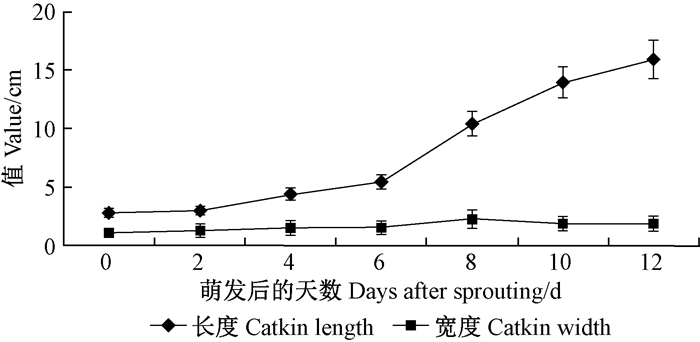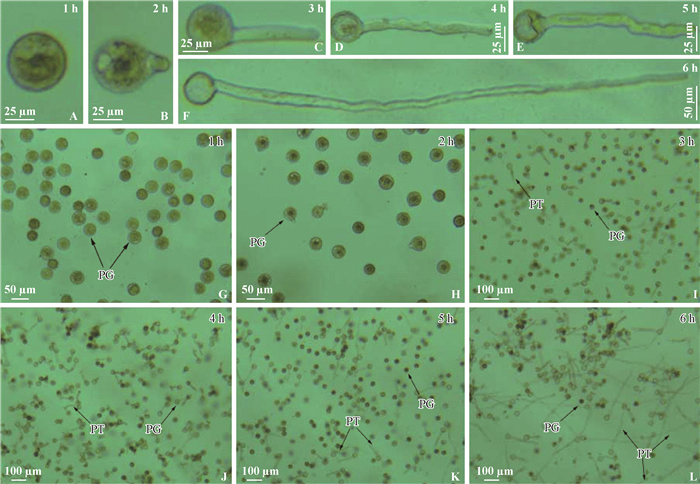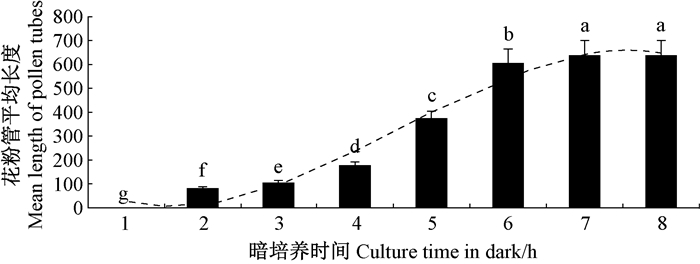文章信息
- 许东, 李际红, 谢兰禹, 亓晓, 王锦楠, 邢世岩
- Xu Dong, Li Jihong, Xie Lanyu, Qi Xiao, Wang Jinnan, Xing Shiyan
- 辽宁杨雄花序发育及花粉萌发特征
- Characteristics of Staminate Catkin Development and Pollen Germination in Populus×liaoningensis
- 林业科学, 2016, 52(8): 38-45
- Scientia Silvae Sinicae, 2016, 52(8): 38-45.
- DOI: 10.11707/j.1001-7488.20160805
-
文章历史
- 收稿日期:2015-07-31
- 修回日期:2015-11-16
-
作者相关文章
2. 山东农业大学科研处 泰安 271018
2. Scientific Research Office, Shandong Agricultural University Tai'an 271018
系统研究花部结构、花序发育进程及花粉萌发规律,既是花粉细胞学研究的前提,也是开展资源保存和杂交育种工作的基础(朱湘渝等,1982; Momose et al., 1998; 张红等,2012)。辽宁杨(Populus×liaoningensis)是鲁克斯杨(Populus deltoides cv. ‘Lux’)和山海关杨(Populus deltoides cv. ‘Shanhaiguan’)的杂交种(刘志成等,1993; 宗凡中,2009),具有速生、抗病、抗旱、耐寒等优良特性,适应范围广,在全国多地均有推广,在湖北、湖南、辽宁等省份表现优良,而在河南、山东等地更是表现出明显的杂种优势(侯开举等,2004; 宗凡中,2009)。因其具备优良的速生及抗逆等性状,可作为杨树新品种培育的理想材料(李善文等,2004)。
花粉生活力是开花植物生物学特性研究的一项重要指标(叶正文等,2010)。花粉离体萌发法以其数据可靠并可完全定量成为杂交育种中花粉生活力测定的首选方法(左丹丹等,2007),在桃(Prunus persica)(郭磊等,2014)、毛叶番荔枝(Annona cherimolia)(Lora et al., 2012)、拟南芥(Arabidopsis thaliana)(Boavida et al., 2007)等植物研究中均有应用,但不同植物的花粉萌发培养基组分存在较大差异。就杨树花粉离体萌发而言,王敬驹等(1975)便对杨属(Populus)5个种及1个杂交种进行了花粉离体培养的相关研究。近期离体萌发法在杨树花粉研究方面的应用更加广泛和深入,如赵丽娟等(2011)对小黑杨(Populus × xiaohei)花粉离体萌发动态的观察、张红等(2012)借离体萌发法对美洲黑杨(Populus deltoides)花粉贮藏方式的筛选等。目前,针对辽宁杨的报道主要集中在区域引种试验(邹济舟等,2003;侯开举等,2004;袁继池等,2013)、生产应用(徐彦军等,2013)及辐射诱变研究(王瑞静等,2009)等方面,而对辽宁杨雄花序发育及花粉离体萌发的研究尚未见报道。将花粉离体萌发法与显微技术结合,在测定花粉生活力的同时进行花粉萌发及花粉管生长动态的细胞学观测,可以为其杂交育种提供技术支持。
本研究通过辽宁杨雄花枝的切枝水培,观测雄花序结构特点及发育进程;设计以蔗糖、H3BO3、Ca2+、温度为变量的正交试验以探讨适合其花粉体外萌发的液体培养基,并对花粉体外萌发动态进行细胞学观测;研究不同贮藏方式对花粉生活力及花粉管生长的影响。以便较为系统地掌握辽宁杨花粉发育特征与贮藏方法,为利用辽宁杨进行良种选育提供依据。
1 材料与方法 1.1 试验材料2015年3月4日采集山东省滨州市姜楼镇八大户村辽宁杨雄花枝,进行适当修剪后带回山东农业大学林学实训基地进行水培,培养温度25 ℃左右,光照强度5 000~10 000 lx。观察雄花枝动态变化并采集其花粉,为后续研究提供试验材料。
1.2 试验方法 1.2.1 辽宁杨雄花序发育过程观察自雄花序萌动起每2天观察1次,每次观察20个花序。对雄花序观察和记录的特征包括花序的平均长度、平均宽度(以1/2长度处为标准测量)、单花的颜色、花丝的长度以及花药的颜色。选择特征明显的花序拍照。
1.2.2 离体萌发液体培养基的筛选用毛笔蘸取少量自然阴干的细粉状花粉,以温度(19,21,23,25 ℃)、蔗糖(120,150,180,210 g·L -1)、H3BO3(10,20,30,40 mg·L-1)、CaCl2(10,20,30,40 mg·L-1)进行4因素4水平共16个组合L16(44)的正交试验,筛选花粉离体萌发适宜的培养条件。在暗培养8 h后对萌发结果进行统计(依据前期预备试验的结果)。各组合设置3个重复,每次重复观测5个视野(每个视野的花粉数≥50);记录视野中的花粉总数、萌发花粉数(视花粉管长度≥花粉直径为萌发),并以5个视野的平均值作为最终结果。
1.2.3 花粉萌发过程的细胞学观察取新鲜花粉,对其进行暗培养,采用显微分析系统每隔1 h取样观测1次,将萌发特征明显的视野保存并随机测量20个花粉的花粉管长度,直至花粉管长度不再发生改变为止。
1.2.4 不同贮藏条件对花粉萌发及花粉管发育的影响设置3个花粉贮藏条件,分别为常温(25 ℃)、4 ℃及-20 ℃,将花粉装入之型管内,放入干燥器中置于常温条件下及4 ℃、-20 ℃冰箱中进行不同贮藏温度处理。试验时以最佳液体培养基暗培养花粉,培养时间8 h。观测花粉萌发率和花粉管长度,具体方法同1.2.2和1.2.3。为了解贮藏前后温度变化对花粉的影响,贮藏前期每2天对各贮藏条件下的花粉观测1次,直至常温贮藏的花粉失去生活力;之后每6天测1次。-20 ℃贮藏的花粉试验前需先在4 ℃的环境中预处理2 h(Vaknin et al., 2000)。
1.3 数据统计分析采用Microsoft Excel 2013软件进行数据分析及图表绘制;SPSS Statistics 20.0软件进行统计分析,包括单因素方差分析以及多重比较。
花粉萌发率=萌发花粉数/花粉总数×100%。本次试验以花粉萌发率表征花粉生活力(王文莉等,2009)。花粉管长度=花粉管前端至花粉粒中心的距离。
2 结果与分析 2.1 辽宁杨雄花序花部特征及发育进程辽宁杨雄花序一般位于1年生小枝顶芽下部,膨大发育时间早于叶芽(图 1A-a)。每个花序上单花数量为40~60个(图 1F),雄蕊着生于膨大的淡黄花托之上(图 1A-c)。

|
图 1 辽宁杨雄花序发育过程及花枝示意 Fig.1 Flowering dynamic of staminate catkin and flowering branch in P.×liaoningensis A:雄花枝生长状态示意图;B-I:雄花序的开花动态。BB:正在开放花芽;L:叶芽;MC:成熟花序;a:雄花枝;b:成熟花序在花枝上的形态;c:单花花柄伸长时花药的状态。 A: Growth situation of staminate catkin; B-I: Flowering dynamic of staminate catkin. BB: Blooming bud; L: Vegetative bud; MC: Mature catkin; a: Staminate flowering branch; b: Mature catkin morphology on the branch; c: State of anther on an extensive stalk of a single flower. |
根据花序发育的特点,将其发育过程分为: 1)花蕾期(图 1B),花芽膨大且由萼片包被,花芽膨大早于叶芽(图 1A-BB,L);2)伸展期(图 1C,D,E),花序逐渐从萼片中伸出,萼片随花序轴的伸长而脱落,苞片附着在单花花柄上,单花紧密排列,花药暗红色;3)盛花期(图 1F,G),单花逐渐分开,花药鲜红色呈团簇状伸向四周(图 1A-c);4)开花末期(图 1H,I),花柄伸长至6~7 mm,花药逐渐由鲜红色转为黄白色,花序柔软、下垂(图 1A-b),花粉极易散落,后花序逐渐枯萎,易从花枝上脱落。
通过一般线性模型(程述汉等,2010)分析花序长度和宽度与培养时间的关系:ylength=2.41t-1.65,Rlength2=0.92;ywidth=0.15t+1.02,Rwidth2=0.70;花序长度和宽度与培养时间呈正相关(图 2)。从图 2可以看出,相同培养时间长度的增幅大于宽度;6~10天花序生长最快,10天后变化幅度放缓;12天后随着花药的成熟,花序长度达到15.9 cm,宽度达到1.89 cm,且不再发生明显变化。

|
图 2 辽宁杨雄花序长度和宽度随培养时间的变化 Fig.2 Dynamic change of length and width of male catkins of P.×liaoningensis with the culture time |
单因素方差及极差分析结果表明,各组花粉萌发率差异显著(P < 0.05),且不同因素对花粉萌发率的影响程度为:蔗糖>H3BO3>CaCl2>温度(表 1)。比较正交试验均值,选取每一组分中花粉萌发率最高的条件,得到最佳培养条件为温度21 ℃,组分210 g·L -1蔗糖+30 mg·L-1H3BO3+10 mg·L-1CaCl2,该组合在正交试验中已出现,即第5组合。与其他组合相比,萌发率处于最高层次且与其他组合差异显著(P < 0.05),其萌发率为58.57%且花粉管生长良好、无异常现象。
|
|
花粉萌发动态过程如图 3所示:暗培养1 h后,花粉吸水膨大(图 3A, G);暗培养2 h后,部分花粉已有萌发迹象(图 3B, H);暗培养3 h后,花粉开始萌发(图 3C, I);暗培养4 h和5 h后,花粉管明显伸长且伸长量不断增加(图 3D, E, J, K),通过分析单位时间内花粉管的伸长长度,发现该时间段也是花粉管伸长最快的时期(图 4);暗培养6 h后,花粉管的生长速率再次趋缓(图 3F, L),暗培养7 h后,其长度不再发生明显变化。

|
图 3 辽宁杨花粉萌发过程的细胞学观察 Fig.3 Cytological observation of P.×liaoningensis pollen germination process A-F:花粉粒萌发的动态过程;G-L:花粉整体萌发的动态过程。G:吸水膨大的花粉粒;H:萌动的花粉粒;I:萌发的花粉粒;J-L:花粉管的生长过程。PG:花粉粒;PT:花粉管。 A-F:Dynamic changes of a single pollen germination; G-L: Dynamic progress of pollen grain germination; G:Water-swelling pollen grain; H:Budding pollen; I:Germinating pollen; J-L:Progress of pollen tube growth. PG:Pollen grain; PT:Pollen tube. |

|
图 4 花粉管长度随暗培养时间延长的动态变化 Fig.4 Dynamic changes of pollen tube length with dark treatment time 虚线为渐近线。不同小写字母表示差异显著(P < 0.05)。下同。 The dotted line is asymptote. The different letters indicate the significant difference at the level of P < 0.05. The same below. |
对各组花粉管长度进行统计分析(图 5),发现第7,9,10,16组合中花粉管平均长度长于其他各组,且与其他各组差异显著(P < 0.05)。正交试验均值比较分析表明,对花粉管生长而言,最佳培养条件为温度23 ℃,组分150 g·L -1蔗糖+ 40 mg·L-1H3BO3+ 10 mg·L-1CaCl2,该组合在正交试验中已出现,即第7组合。

|
图 5 培养7 h时各培养基花粉管平均长度 Fig.5 Average length of the pollen tubes in different medium after 7 hours 培养基编号同表 1。 No. for culture mediums were the same with Tab.1. |
综合2.2和2.4的试验结果,并对花粉萌发率及花粉管长度进行SPSS双变量相关分析,结果为P=0.225>0.05的显著性水平。说明花粉萌发率与花粉管长度不存在相关关系,研究时应考虑区别对待。
2.5 不同贮藏方式对花粉体外萌发的影响常温下贮藏仅1天,花粉生活力降至29.53%,7天后即失去生活力(图 6),此时4 ℃下贮藏的花粉,其生活力仍为15.46%,-20 ℃贮藏的花粉,其生活力仍高达36.52%;4 ℃下贮藏19天,花粉失去生活力(图 6),-20 ℃下的花粉此时却仍有30.39%的生活力;贮藏43天时,-20 ℃下的花粉,其生活力仍保持在10.12%,54天后失去生活力。由此推测,贮藏温度越低,生活力的变化越缓慢,表现为贮藏时间的延长;同一贮藏温度下花粉生活力随贮藏时间的延长而降低。对花粉管长度的观测表明,同一贮藏温度下,贮藏时间越长,花粉管越短(图 7);贮藏时间相同时,贮藏温度越低,花粉管越长(图 7C, D, F, G)。综合2.2和2.4的结论认为,若是利用贮藏花粉进行杂交试验,授粉次数应增多,授粉的时间间隔应延长。

|
图 6 不同贮藏时间对花粉生活力的影响 Fig.6 Viability change of pollen for different storing time |

|
图 7 不同贮藏温度下花粉管的动态变化(培养基中培养7 h) Fig.7 Dynamic change of pollen tube in different storage temperatures(7 hours' culture in the medium) A:新鲜花粉花粉管生长情况;B:常温下贮藏5天时花粉管生长情况;C:常温下贮藏7天时花粉管生长情况;D:4 ℃下贮藏7天时花粉管生长情况;E:4 ℃下贮藏13天时花粉管生长情况;F:4 ℃下贮藏19天时花粉管生长情况;G:-20 ℃下贮藏19天时花粉管生长情况;H:-20 ℃下贮藏43天时花粉管生长情况;I:-20 ℃下贮藏49天时花粉管生长情况。RT:常温。 A:Tube growth of fresh pollen; B:Tube growth of pollen stored in room temperature after 5 days of storage; C:Tube growth of pollen stored in room temperature after 7 days of storage; D:Tube growth of pollen stored in 4 ℃ after 7 days of storage; E:Tube growth of pollen stored in 4 ℃ after 13 days of storage; F:Tube growth of pollen stored in 4 ℃ after 19 days of storage; G:Tube growth of pollen stored in -20 ℃ after 19 days of storage; H:Tube growth of pollen stored in -20 ℃ after 43 days of storage; I:Tube growth of pollen stored in -20 ℃ after 49 days of storage. RT:Room temperature. |
受精是一个微妙而精确的过程(Weterings et al., 2004),该过程中任何一个环节出现问题都有可能引发胚败育(朱玉玲等,2013)。为保证杂交育种工作的顺利进行,需要对受精的各个环节进行系统性地把控。
传粉始于花药开裂和花粉散出(郝瑞娟等,2008)。陈雄伟等(2013)研究发现,紫背天葵(Begonia fimbristipula)单花花期10天左右,有明显花被片。杨尚尚等(2013)对石榴(Punica granatum)的研究表明,石榴花期18天左右,同样具有极为明显的花被片。本试验对辽宁杨开花动态的观察发现:辽宁杨单花花期持续12天,花被片早落,花药伸出而朝向不一,具有鲜明的风媒花特点(图 1A-c),这些特点与Hamrick(1982)关于风媒花特点的叙述类似。花药开裂时花粉集中在花药表面,轻微触动即可导致花粉大量散落。据此结果推测花粉应在花药开裂前采集,可参考Merchant等(1992)陈述的方法在将花药一并采下阴干后对花粉进行保存,从而保证花粉质量并减少不必要的花粉损失。
花粉离体萌发是多种因素共同作用的结果(Gaaliche et al., 2013)。对比黑杨派(Sect. Aigeiros)不同品种的花粉离体萌发培养基发现,品种不同适宜花粉萌发的培养基组成不同(朱湘渝等,1982;赵雁鸣等,2014)。赵丽娟等(2011)在分析培养基中不同因素对花粉离体萌发的影响程度时,认为温度>蔗糖>H3BO3>CaCl2,这与本次试验的结果(蔗糖>H3BO3>CaCl2>温度)存在一定的差异,其主要区别点在于温度,与小黑杨相比,温度对于辽宁杨花粉萌发的影响程度更小。据此推测辽宁杨对温度的适应范围可能大于小黑杨。
花粉萌发率和花粉管生长是花粉萌发生物学特性中的2个重要方面,同时也是植物结实的基础,是决定杂交育种工作成败的关键(张红等,2012;杨尚尚等,2013)。本研究表明花粉萌发率和花粉管长度二者不存在相关关系。Kalinganire等(2000)对银桦(Grevillea robusta)花粉萌发的研究结果也说明这一问题。但分析正交试验中4个因素对二者的影响程度时却发现,影响程度均是蔗糖>H3BO3>CaCl2>温度,主要区别在于浓度。赵丽娟等(2011)认为一定浓度范围内随着蔗糖浓度的增加,花粉萌发率也会升高;硼和钙则通过相互作用促进花粉管的正常生长。
明确贮藏条件对花粉萌发的影响是利用贮藏花粉进行杂交试验的前提。贮藏花粉的温度条件主要有常温及4,-20,-70,-80,-196 ℃(Vaknin et al., 2000; Fernando et al., 2006; Machado et al., 2014; 张洪伟等,2014), 其中,常温、4 ℃、-20 ℃是实际生产过程中较易满足的温度条件。试验结果表明,常温下花粉萌发率下降最快,保存1天,50%左右的花粉即失去生活力;-20 ℃条件下,花粉贮藏天数可达到54天;而4 ℃下花粉的贮藏天数在二者之间。这一研究结果与张红等(2012)对4个美洲黑杨花粉贮藏的研究结果以及杜克兵等(2007)对辽宁杨花粉贮藏的研究结果类似。-20 ℃适于较长时间的花粉贮藏;4 ℃适于对花粉的短期贮藏。据此推测,贮藏温度越低,贮藏效果可能越好,贮藏时间也可相应延长。
张绍铃等(2003)认为,与萌发率相比,花粉管长度更能表现代谢活力,并与受精的关系更为密切。对比相同培养时间内,贮藏花粉与新鲜花粉的花粉管长度,进一步说明低温贮藏可能是通过降低花粉的代谢强度以延长贮藏时间。本试验结果表明,贮藏时间越长,相同培养时间内花粉管长度越短。由此看来,若是利用贮藏花粉进行杂交试验,需要对杂交试验授粉次数等进行相应调整。
4 结论辽宁杨雄花序从萌发到成熟约12天,可依次分为4个阶段:花蕾期、伸展期、盛花期、开花末期。处于第4阶段的花序,其花粉易散落,采集时需注意。花粉体外萌发试验表明,花粉萌发率和花粉管长度不存在相关关系,研究时应区别对待。贮藏时间相同时,-20 ℃贮藏的花粉其萌发率以及相同培养时间下花粉管伸长的长度大于4 ℃以及室温下贮藏的花粉。因此,使用经贮藏的花粉进行杂交试验,应根据不同的贮藏条件对授粉方式进行调整,如在贮藏时间相同时,以4 ℃贮藏的花粉代替-20 ℃贮藏的花粉进行杂交试验,可考虑增加授粉次数并适当延长授粉时间间隔,以取得相同的或较好的授粉效果。通过对辽宁杨开花过程、花粉萌发过程以及花粉贮藏过程的记录与分析,为杨树花粉研究及杨树杂交试验提供了理论依据与技术支持,使实践过程更加高效、有序。
| [] |
陈雄伟, 邵玲, 梁广坚, 等. 2013. 紫背天葵花部特征与繁育系统的研究. 园艺学报 , 40 (2) : 363–372.
( Chen X W, Shao L, Liang G J, et al.2013. A study on floral syndrome and breeding system of Begonia fimbristipula Hance. Acta Horticulturae Sinica , 40 (2) : 363–372. [in Chinese] ) (  0) 0)
|
| [] |
程述汉, 舒兴明. 2010. 大学数学——概率论与数理统计. 北京: 高等教育出版社 .
( Cheng S H, Shu X M. 2010. University mathematics:Probability theory & mathematical statistics. Beijing: Higher Education Press . [in Chinese] ) |
| [] |
杜克兵, 沈宝仙, 许林, 等. 2007. 不同贮藏条件下杨树花粉活力变化及隔年杂交授粉应用的可行性研究. 华中农业大学学报 , 26 (3) : 385–389.
( Du K B, Shen B X, Xu L, et al.2007. Changes of viability of stored poplar pollens and its feasibility for cross breeding. Journal of Huazhong Agricultural University , 26 (3) : 385–389. [in Chinese] ) (  0) 0)
|
| [] |
郭磊, 张斌斌, 马瑞娟, 等. 2014. 温度对桃离体花药散粉及花粉萌发的影响. 植物生理学报 , 50 (3) : 269–274.
( Guo L, Zhang B B, Ma R J, et al.2014. Effect of temperature on the pollen dissemination and germination of peach. Plant Physiology Journal , 50 (3) : 269–274. [in Chinese] ) (  0) 0)
|
| [] |
郝瑞娟, 王周锋, 穆鼎. 2008. 不同百合花粉活力的测定方法比较. 北方园艺 , 32 (11) : 95–97.
( Hao R J, Wang Z F, Mu D.2008. Study on different methods of the pollen vitality Lilium. Northern Horticulture , 32 (11) : 95–97. [in Chinese] ) (  0) 0)
|
| [] |
侯开举, 周忠诚, 雷钧, 等. 2004. 鲁山杨等杨树优良无性系的推广应用. 湖北林业科技 (S1) : 92–94.
( Hou K J, Zhou Z C, Lei J, et al.2004. Popularization and application of excellent clones from poplar varieties including Lushan poplar. Hubei Forestry Science and Technology (S1) : 92–94. [in Chinese] ) (  0) 0)
|
| [] |
李善文, 张志毅, 何承忠, 等. 2004. 中国杨树杂交育种研究进展. 世界林业研究 , 17 (2) : 37–41.
( Li S W, Zhang Z Y, He C Z, et al.2004. Progress on hybridization breeding of poplar in China. World Forestry Research , 17 (2) : 37–41. [in Chinese] ) (  0) 0)
|
| [] |
刘志成, 陈鸿雕, 潘成良, 等. 1993. 鲁×山、山×哈、72×山杨树硬枝扦插试验. 辽宁林业科技 (3) : 7–10, 64..
( Liu Z C, Chen H D, Pan C L, et al.1993. Study on cutting propagetion of Populus × liaoningensis, Populus × liaohenica, Populus×gaixianensis. Liaoning Forestry Science and Technology (3) : 7–10, 64.. [in Chinese] ) (  0) 0)
|
| [] |
王瑞静, 王瑞文, 沈宝仙. 2009. 60Coγ射线对杨树种子的辐射效应. 核农学报 , 23 (5) : 762–765.
( Wang R J, Wang R W, Shen B X.2009. Effection of 60Coγ-rays irradiation on poplar seeds. Journal of Nuclear Agricultural Sciences , 23 (5) : 762–765. [in Chinese] ) (  0) 0)
|
| [] |
王文莉, 赵兰勇, 朱翠英, 等. 2009. 平阴玫瑰花粉生活力及其贮藏条件的研究. 园艺学报 , 36 (4) : 593–598.
( Wang W L, Zhao L Y, Zhu C Y, et al.2009. Study on pollen viability and its storage conditions of Pingyin rose. Acta Horticulturae Sinica , 36 (4) : 593–598. [in Chinese] ) (  0) 0)
|
| [] |
王敬驹, 朱至清, 孙敬三. 1975. 杨树花粉植株的诱导. 植物学报 , 17 (1) : 56–59.
( Wang J J, Zhu Z Q, Sun J S.1975. The induction of Populus pollen-plants. Chinese Bulletin of Botany , 17 (1) : 56–59. [in Chinese] ) (  0) 0)
|
| [] |
徐彦军, 吴秀泉, 宋世良, 等. 2013. 不同速生树种培养料对黑木耳生长及产量的影响. 北方园艺 , 37 (10) : 143–145.
( Xu Y J, Wu X Q, Song S L, et al.2013. Effect of different culture material of fast-growing trees on the growth and yield of Auricularia auricula. Northern Horticulture , 37 (10) : 143–145. [in Chinese] ) (  0) 0)
|
| [] |
杨尚尚, 苑兆和, 李云, 等. 2013. 石榴'泰山红'的花粉萌发生物学特性. 林业科学 , 49 (10) : 48–53.
( Yang S S, Zhao Z H, Li Y, et al.2013. Biological characteristics of pollen germination of 'Taishanhong' pomegranate. Scientia Silvae Sinicae , 49 (10) : 48–53. [in Chinese] ) (  0) 0)
|
| [] |
袁继池, 周忠诚, 侯开举, 等. 2013. 不同杨树品种冠径比的差异性分析. 湖北林业科技 (2) : 18–20.
( Yuan J C, Zhou Z C, Hou K J, et al.2013. Difference analysis of crown diameter ration of different poplar varieties. Hubei Forestry Science and Technology (2) : 18–20. [in Chinese] ) (  0) 0)
|
| [] |
叶正文, 杜纪红, 苏明申, 等. 2010. 桃92个品种的花粉量及其萌发特性的差异. 园艺学报 , 37 (4) : 525–531.
( Ye Z W, Du J H, Su M S, et al.2010. Cluster analysis for the quantity and germinating characteristics of the pollens from 92 peach cultivars. Acta Horticulturae Sinica , 37 (4) : 525–531. [in Chinese] ) (  0) 0)
|
| [] |
张洪伟, 段一凡, 李稚, 等. 2014. 不同贮藏方法对桂花花粉活力影响的研究. 南京林业大学学报:自然科学版 , 38 (S1) : 7–12.
( Zhang H W, Duan Y F, Li Z, et al.2014. Study on effects of different storage methods on pollen vitality of Osmanthus fragrans. Journal of Nanjing Forestry University:Natural Science Edition , 38 (S1) : 7–12. [in Chinese] ) (  0) 0)
|
| [] |
张红, 冒燕, 李淑娴. 2012. 4个美洲黑杨无性系花粉的贮藏与萌发特性. 种子 , 31 (1) : 85–87.
( Zhang H, Mao Y, Li S X.2012. Study on pollen viability and storage methods of four Populus deltoides clones. Seed , 31 (1) : 85–87. [in Chinese] ) (  0) 0)
|
| [] |
张绍铃, 梅正敏, 陈迪新. 2003. 果梅花粉离体萌发及花粉管生长影响因子的研究. 中国农学通报 , 19 (2) : 21–25.
( Zhang S L, Mei Z M, Chen D X.2003. A study on factors affecting in vitro pollen germination and tube growth of Prunus mume. Chinese Agricultural Science Bulletin , 19 (2) : 21–25. [in Chinese] ) (  0) 0)
|
| [] |
赵雁鸣, 张雪娟, 赵月明, 等. 2014. 贮藏温度和时间对滇杨花粉萌发的影响. 贵州农业科学 , 42 (6) : 133–136.
( Zhao Y M, Zhang X J, Zhao Y M, et al.2014. Effects of storage temperature and time on Populus yunnanensis pollen germination. Guizhou Agricultural Science , 42 (6) : 133–136. [in Chinese] ) (  0) 0)
|
| [] |
赵丽娟, 李淑娟, 于金海, 等. 2011. 小黑杨花粉离体萌发和细胞学分析. 林业科学 , 47 (6) : 36–41.
( Zhao L J, Li S J, Yu J H, et al.2011. In vitro germination and cytology analysis of Populus simonii×P. nigra pollen.Scientia Silvae Sinicae , 47 (6) : 36–41. [in Chinese] ) (  0) 0)
|
| [] |
朱玉玲, 彭建营, 张玉星. 2013. '无核世纪梨'授粉受精过程及种子败育的观察. 园艺学报 , 40 (7) : 1244–1250.
( Zhu Y L, Peng J Y, Zhang Y X.2013. The observation of pollination fertilization and seed abortion of 'Century Seedless Pear'. Acta Horticulturae Sinica , 40 (7) : 1244–1250. [in Chinese] ) (  0) 0)
|
| [] |
朱湘渝, 王瑞玲. 1982. 杨树花粉生活力测定和贮藏试验. 林业科技通讯 (3) : 1–4.
( Zhu X Y, Wang R L.1982. Pollen viability test and preservation in poplar. Forest Science and Technology (3) : 1–4. [in Chinese] ) (  0) 0)
|
| [] |
宗凡中. 2009. 长江滩地杨树新品种栽培试验初报. 安徽农学通报 , 15 (17) : 190–191.
( Zong F Z.2009. Primary report on cultivation experiments of a new species of the poplar on beach land of Yangtse river. Anhui Agricultural Science Bulletin , 15 (17) : 190–191. [in Chinese] ) (  0) 0)
|
| [] |
邹济舟, 陈冬民, 刘恒贵, 等. 2003. 杨树新品种苗期对比试验初报. 湖北林业科技 (3) : 8–10.
( Zou J Z, Chen D M, Liu H G, et al.2003. Primary report on contrast test among new poplar varieties in seeding stage. Hubei Forestry Science and Technology (3) : 8–10. [in Chinese] ) (  0) 0)
|
| [] |
左丹丹, 明军, 刘春, 等. 2007. 植物花粉生活力检测技术进展. 安徽农业科学 , 35 (16) : 4742–4745.
( Zuo D D, Ming J, Liu C, et al.2007. Advance in technique of plant pollen viability. Anhui Agricultural Science , 35 (16) : 4742–4745. [in Chinese] ) (  0) 0)
|
| [] |
Boavida L C, Mccormick S.2007. Temperature as a determinant factor for increased and reproducible in vitro pollen germination in Arabidopsis thaliana. Plant Journal for Cell&Molecular Biology , 52 (3) : 570–582.
( 0) 0)
|
| [] |
Fernando D D, Richards J L, Kikkert J R.2006. In vitro germination and transient GFP expression of American chestnut (Castanea dentata) pollen. Plant Cell Reports , 25 (5) : 450–456.
DOI:10.1007/s00299-005-0088-z ( 0) 0)
|
| [] |
Gaaliche B, Majdoub A, Trad M, et al.2013. Assessment of pollen viability, germination, and tube growth in eight tunisian caprifig (Ficus carica L.) cultivars. Isrn Agronomy .
DOI:10.1155/2013/207434 ( 0) 0)
|
| [] |
Hamrick J L.1982. Plant population genetics and evolution. American Journal of Botany , 69 (10) : 1685–1693.
DOI:10.2307/2442923 ( 0) 0)
|
| [] |
Lora J, Herrero M, Hormaza J I.2012. Pollen performance, cell number, and physiological state in the early-divergent angiosperm Annona cherimola Mill. (Annonaceae) are related to environmental condition during the final stage of pollen development.Sex Plant Reprod , 25 (3) : 157–167.
( 0) 0)
|
| [] |
Kalinganire A, Harwood C E, Slee M U, et al.2000. Floral structure, stigma receptivity and pollen viability in relation to protandry and self-incompatibility in silky oak (Grevillea robusta A Cunn.). Annals of Botany , 86 (1) : 133–148.
DOI:10.1006/anbo.2000.1170 ( 0) 0)
|
| [] |
Machado C D A, Moura C R F, Lemos E E P D, et al.2014. Pollen grain viability of coconut accessions at low temperatures. Acta Sci Agron , 36 (2) : 227–232.
DOI:10.4025/actasciagron.v36i2.17346 ( 0) 0)
|
| [] |
Merchant R, Power J B, Davey M R, et al.1992. Cryopreservation of pollen from two rose cultivars. Euphytica , 66 (3) : 235–241.
( 0) 0)
|
| [] |
Momose K, Yumoto T, Nagamitsu T, et al.1998. Pollination biology in a lowland dipterocarp forest in Sarawak, Malaysia I. Characteristics of the plant-pollinator community in a lowland dipterocarp forest.American Journal of Botany , 85 (10) : 1477–1501.
( 0) 0)
|
| [] |
Vaknin Y, Eisikowitch D.2000. Effects of short-term storage on germinability of pistachio pollen. Plant Breeding , 119 (4) : 347–350.
DOI:10.1046/j.1439-0523.2000.00508.x ( 0) 0)
|
| [] |
Weterings K, Russell S D.2004. Experimental analysis of the fertilization process. Plant Cell , 16 (suppl 1) : S107–S118.
( 0) 0)
|
 2016, Vol. 52
2016, Vol. 52

